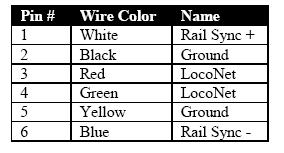LocoNet typically supports a total cable length of up to 2,000 feet with no two devices connected by more than 600 feet of cable. LocoNet wiring is totally free-form.
We do not recommend looping LocoNet back on itself.
Making your own LocoNet Cables is simple and cost effective. LocoNet wiring consists of readily available wire and connectors. LocoNet uses flat 6 conductor wire and 6-pin RJ12 connectors. This kind of wiring is typically used for telephone wiring. Most Digitrax dealers can make up LocoNet cables for you.
If you plan on wiring a large layout, you may want to invest in a good quality set of crimpers so you can make your own LocoNet cables. The LT1 tester can be used to test LocoNet cables to be certain they are good before you install them on your layout. Many layout problems we see are related to LocoNet cables that were not built or crimped correctly.
LocoNet cables are wired pin 1 to pin 1. When you hold the plug with the tab up and look into the end of the connector you will see the wires listed below in the chart starting at the left side and moving to the right. (This is sometimes called a “reversing cable” in the telecommunications industry even though it really does not reverse).
We use the following wiring convention for all LocoNet cables/connections :
Put another way, Pins 1 & 6 carry track power, Pins 3 & 4 carry data and Pins 2 & 5 are ground connections.

